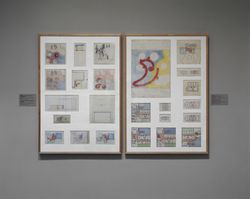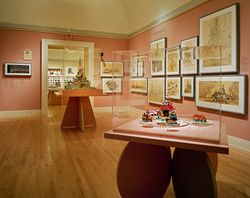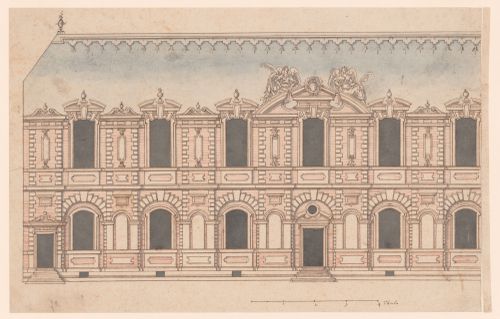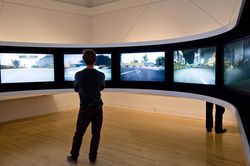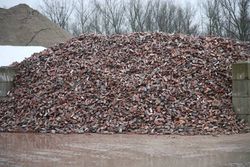photographs
PHCON2002:0016:002:002
Description:
Sheet of 12 square contact prints showing Sebastian Matta posing and playing a guitar; A painting and a drawing by Roberto Matta hang on the wall in the background of most of the photographs.
ca. 1962
Contact sheet of 12 portraits of Sebastian Matta
Actions:
PHCON2002:0016:002:002
Description:
Sheet of 12 square contact prints showing Sebastian Matta posing and playing a guitar; A painting and a drawing by Roberto Matta hang on the wall in the background of most of the photographs.
photographs
ca. 1962
Paul Nelson (1895–1979), American architect, film set designer, painter, critic, and educator, taught and practised architecture in the United States and France for over fifty years. Nelson was a central figure in the development of functionalism in the 1930s and 1940s, which rejected the Beaux-Arts language in favour of technological and functional expression. The Filter(...)
Main galleries
27 March 1991 to 26 May 1991
The Filter of Reason: The Work of Paul Nelson
Actions:
Description:
Paul Nelson (1895–1979), American architect, film set designer, painter, critic, and educator, taught and practised architecture in the United States and France for over fifty years. Nelson was a central figure in the development of functionalism in the 1930s and 1940s, which rejected the Beaux-Arts language in favour of technological and functional expression. The Filter(...)
Main galleries
Series
Architectural projects
AP018.S1
Description:
The Architectural Projects series, 1945-1986, is the largest series in the fonds and documents the projects worked on by Parkin’s two firms throughout his career. These projects include built work, urban planning, proposals, competitions and feasibility studies. The majority of the projects were based in Toronto and the surrounding area, but projects from across Canada and some international projects in the Caribbean, Middle East, and Northern Africa are also included. These individual projects were identified and separated based on distinct project numbers assigned by the creating offices. The general numbering rule at the offices was two digits to represent the year, followed by two or three digits to represent the consecutive project number for that year (YY###). For instance the 7th project taken on in the year 1980 would be assigned the project number 8007. This chronological ordering has been respected in the arrangement of this series. These projects are recorded primarily through textual records and drawings, but some photographs, paintings, artefacts and one book are also included in this series. The amount of drawings and textual materials for the projects vary greatly. Materials for projects before 1971, from the firm John B. Parkin Associates, are very sparse, sometimes with only a few files or drawings representing a project. Materials after 1971, from the firm Parkin Architects Planners, are much more complete and often contain drawings from initial sketches to finished construction work. Among these drawings are plans, elevations, sections, details, perspectives, and mechanical, electrical and structural drawings. Textual records for these projects typically include correspondence, meeting minutes, specifications, site reports, consultancy files and other construction documentation. The photographic materials in this series often show construction progress and completed work. Also present are presentation panels with mounted drawings, photographs and paintings for some projects. The artefacts typically consist of material samples for construction. The textual records for projects are almost always in English, but some drawings are in French or are bilingual for projects commissioned by the Government of Canada. Although John C. Parkin is the creator of this series, the partners at his firms and other employees played a significant role as creators of the contents. Especially in the material from Parkin Architects Planners, the names of his partners such as J.B. Mar, P.H. Warren, D.L. Wilson, and L. Payne are often marked as authors of the materials.
1945-1986
Architectural projects
Actions:
AP018.S1
Description:
The Architectural Projects series, 1945-1986, is the largest series in the fonds and documents the projects worked on by Parkin’s two firms throughout his career. These projects include built work, urban planning, proposals, competitions and feasibility studies. The majority of the projects were based in Toronto and the surrounding area, but projects from across Canada and some international projects in the Caribbean, Middle East, and Northern Africa are also included. These individual projects were identified and separated based on distinct project numbers assigned by the creating offices. The general numbering rule at the offices was two digits to represent the year, followed by two or three digits to represent the consecutive project number for that year (YY###). For instance the 7th project taken on in the year 1980 would be assigned the project number 8007. This chronological ordering has been respected in the arrangement of this series. These projects are recorded primarily through textual records and drawings, but some photographs, paintings, artefacts and one book are also included in this series. The amount of drawings and textual materials for the projects vary greatly. Materials for projects before 1971, from the firm John B. Parkin Associates, are very sparse, sometimes with only a few files or drawings representing a project. Materials after 1971, from the firm Parkin Architects Planners, are much more complete and often contain drawings from initial sketches to finished construction work. Among these drawings are plans, elevations, sections, details, perspectives, and mechanical, electrical and structural drawings. Textual records for these projects typically include correspondence, meeting minutes, specifications, site reports, consultancy files and other construction documentation. The photographic materials in this series often show construction progress and completed work. Also present are presentation panels with mounted drawings, photographs and paintings for some projects. The artefacts typically consist of material samples for construction. The textual records for projects are almost always in English, but some drawings are in French or are bilingual for projects commissioned by the Government of Canada. Although John C. Parkin is the creator of this series, the partners at his firms and other employees played a significant role as creators of the contents. Especially in the material from Parkin Architects Planners, the names of his partners such as J.B. Mar, P.H. Warren, D.L. Wilson, and L. Payne are often marked as authors of the materials.
Series
1945-1986
photographs
Quantity:
32 slide(s)
ARCH270031
Description:
Group consists of photographs of buildings in sector 23 in Chandigarh, India, including schools, group housings and sports installations and clubs. The group also includes photographs of young boys playing baseball.
June 12, 1987
Photographs of buildings in sector 23 in Chandigarh
Actions:
ARCH270031
Description:
Group consists of photographs of buildings in sector 23 in Chandigarh, India, including schools, group housings and sports installations and clubs. The group also includes photographs of young boys playing baseball.
photographs
Quantity:
32 slide(s)
June 12, 1987
Disneyland, with its far-flung colonies in Florida, Japan, and France, is a key symbol of contemporary American culture that has been both celebrated and attacked as the ultimate embodiment of consumer society, of simulation and pastiche, of the blurring of distinctions between reality and mass-media imagery. The Architecture of Reassurance: Designing the Disney Theme(...)
Main galleries
17 June 1997 to 28 September 1997
The Architecture of Reassurance: Designing the Disney Theme Parks
Actions:
Description:
Disneyland, with its far-flung colonies in Florida, Japan, and France, is a key symbol of contemporary American culture that has been both celebrated and attacked as the ultimate embodiment of consumer society, of simulation and pastiche, of the blurring of distinctions between reality and mass-media imagery. The Architecture of Reassurance: Designing the Disney Theme(...)
Main galleries
Elevation of a palace façade
DR1970:0003
Description:
This drawing shows an exterior of a residential building. The artist uses color to suggest the materials used in construction; blue-grey for the pitched slate roof, brown for masonry details and architectural sculpture, and red striations for brickwork. This combination of materials was common in early modern France, where a play on color and materiality enlivened the façades of well-known royal edifices including the chateaux of Fontainebleau and Saint-Germain-en-Laye. As with the construction technique that interwove stone with brick, the architectural style depicted in the drawing combines traditional French ideas about building with classicizing elements imported to France via Italian artists and architects as well as through printed translations of Vitruvius’s 'De architectura' and Sebastiano Serlio’s architectural treatise. The inclusion of masonry rustication and the decorative urns that punctuate the roofline suggest a knowledge of classicizing trends in architectural ornament and a familiarity with the œuvre of artists working in the circle of the first and second Écoles de Fontainebleau. The structure’s elongated form suggests a gallery and the organization of the façade borrows the combination of slightly protruding vertical bays and long horizontal registers that characterizes Pierre Lescot’s wing of the Louvre, a project that would have been well-known in court circles in the latter half of the sixteenth century. Similarly, the two winged allegorical figures flanking the central pediment are reminiscent of Jean Goujon’s sculptural additions to the Lescot wing. In the Canadian Centre for Architecture’s drawing both figures hold palms, but the artist omitted any further identifying attributes, perhaps – along with the empty niches – as an invitation for the patron to imagine his or her own thematic program for the project.
first quarter of the 16th century
Elevation of a palace façade
Actions:
DR1970:0003
Description:
This drawing shows an exterior of a residential building. The artist uses color to suggest the materials used in construction; blue-grey for the pitched slate roof, brown for masonry details and architectural sculpture, and red striations for brickwork. This combination of materials was common in early modern France, where a play on color and materiality enlivened the façades of well-known royal edifices including the chateaux of Fontainebleau and Saint-Germain-en-Laye. As with the construction technique that interwove stone with brick, the architectural style depicted in the drawing combines traditional French ideas about building with classicizing elements imported to France via Italian artists and architects as well as through printed translations of Vitruvius’s 'De architectura' and Sebastiano Serlio’s architectural treatise. The inclusion of masonry rustication and the decorative urns that punctuate the roofline suggest a knowledge of classicizing trends in architectural ornament and a familiarity with the œuvre of artists working in the circle of the first and second Écoles de Fontainebleau. The structure’s elongated form suggests a gallery and the organization of the façade borrows the combination of slightly protruding vertical bays and long horizontal registers that characterizes Pierre Lescot’s wing of the Louvre, a project that would have been well-known in court circles in the latter half of the sixteenth century. Similarly, the two winged allegorical figures flanking the central pediment are reminiscent of Jean Goujon’s sculptural additions to the Lescot wing. In the Canadian Centre for Architecture’s drawing both figures hold palms, but the artist omitted any further identifying attributes, perhaps – along with the empty niches – as an invitation for the patron to imagine his or her own thematic program for the project.
events
Speed and its Limits
Speed and its Limits explores the pivotal role played by speed in modern life: from art to architecture and urbanism to graphics and design to economics to the material culture of the eras of industry and information. A colloquium organised by the CCA, in collaboration with the Wolfsonian-Florida International University and Stanford Humanities Lab, in preparation for the(...)
Paul Desmarais Theatre
21 June 2008, 9am - 5pm
Speed and its Limits
Actions:
Description:
Speed and its Limits explores the pivotal role played by speed in modern life: from art to architecture and urbanism to graphics and design to economics to the material culture of the eras of industry and information. A colloquium organised by the CCA, in collaboration with the Wolfsonian-Florida International University and Stanford Humanities Lab, in preparation for the(...)
events
21 June 2008
9am - 5pm
Paul Desmarais Theatre
Speed Limits
Speed Limits addresses the pivotal role played by speed in modern life: from art to architecture and urbanism to graphics and design to economics to the material culture of the eras of industry and information. It marks the centenary of the foundation of the Italian Futurist movement, whose inaugural manifesto famously proclaimed “that the world’s magnificence has been(...)
Main galleries
20 May 2009 to 8 November 2009
Speed Limits
Actions:
Description:
Speed Limits addresses the pivotal role played by speed in modern life: from art to architecture and urbanism to graphics and design to economics to the material culture of the eras of industry and information. It marks the centenary of the foundation of the Italian Futurist movement, whose inaugural manifesto famously proclaimed “that the world’s magnificence has been(...)
Main galleries
textual records
Quantity:
6 textual record(s)
6804 / Stadium "Baseball"
ARCH267465
Description:
This group consists of memos, correspondence and related documents concerning the Expo '67 Stadium in Montréal, Québec. There are also clippings of articles from the "Montreal Star" and "The Gazette" about the possibility of having a baseball team playing at the Stadium.
1968
6804 / Stadium "Baseball"
Actions:
ARCH267465
Description:
This group consists of memos, correspondence and related documents concerning the Expo '67 Stadium in Montréal, Québec. There are also clippings of articles from the "Montreal Star" and "The Gazette" about the possibility of having a baseball team playing at the Stadium.
textual records
Quantity:
6 textual record(s)
1968
Learning from... Brussels
Rotor members Michael Ghyoot and Maarten Gielen investigate the processes and practices of material management in Brussels and its suburbs. The concept of waste played a key role in their research and was informed by hundreds of visits to businesses, work sites, and recycling plants. The examination of discarded, unfinished products or those considered of inferior quality(...)
Paul Desmarais Theatre
19 April 2012 , 7pm
Learning from... Brussels
Actions:
Description:
Rotor members Michael Ghyoot and Maarten Gielen investigate the processes and practices of material management in Brussels and its suburbs. The concept of waste played a key role in their research and was informed by hundreds of visits to businesses, work sites, and recycling plants. The examination of discarded, unfinished products or those considered of inferior quality(...)
Paul Desmarais Theatre
